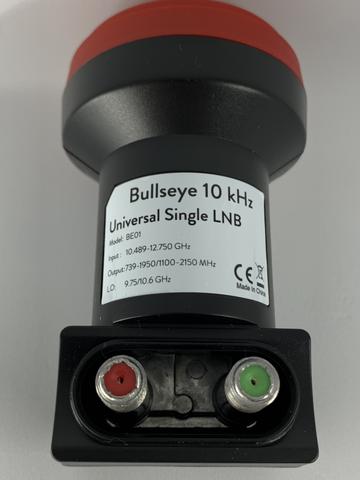Othernet have recently released their new
"Bullseye" 10 kHz Ultra High Stability Universal LNB. It is currently on sale and available for US$39.95 + shipping on their store. The LNB is designed for receiving QO-100 which is a popular geostationary amateur radio satellite positioned at 25.5°E which covers Africa, Europe, the Middle East, India, eastern Brazil and the west half of Russia/Asia. In the past we've seen several posts about people using RTL-SDRs to set up ground station monitors for this satellite, as well as
special WebSDR software designed for QO-100 monitoring. Typically an LNB with small satellite dish is used to receive QO-100 which downlinks at 10.489550 GHz. These LNB's have a built in LNA, and downconvert the signal into a frequency range receivable by an RTL-SDR. One problem is that most commercial LNBs were intended for satellite TV reception, and hence they do not need to use a very stable local oscillator. So reception of the narrowband signals on QO-100 can become a challenge if they are continuously drifting in frequency as temperature changes. Othernet's new Bullsye LNB uses a 2PPM TCXO as the local oscillator which gives it high stability in the face of changing temperatures. To power it you'll need a bias tee or LNB power source capable of injecting 13 - 18v onto the coax line. The product description reads: The Bullseye LNB is the world's most precise and stable Ku-band down converter. Even a VSAT LNBF costing hundreds of dollars more is no match for the performance of the Bullseye 10K LNB. Each unit is calibrated at the factory to within 1 kHz of absolute precision against a GPS-locked spectrum analyzer. As a bonus feature, the Bullseye 10K provides access to its internal 25 MHz TCXO through the secondary F-connector. This reference output can be used to directly monitor the performance of the TCXO over time.
- Bullseye 10 kHz BE01
- Phase locked loop with 2 PPM TCXO
- Factory calibration within 1 kHz utilizing GPS-locked spectrum analyzers
- Ultra high precision PLL employing proprietary frequency control system (patent pending)
- Digitally controlled carrier offset with optional programmer
- 25 MHz output reference available on secondary F-connector (red)
- Input frequency: 10489 - 12750 MHz
- LO frequency 9750/10600 MHz
- LO frequency stability at 23C: +/- 10 kHz
- LO frequency stability -20 - 60C: +/- 30 kHz
- Gain: 50 - 66 dB
- Output frequency: 739 - 1950 MHz (low band) and 1100 - 2150 (high band)
- Return loss of 8 dB (739 - 1950 MHz) and 10 dB (1100 - 2150 MHz)
- Noise figure: 0.5 dB
Over on his blog @F4DAV has
uploaded a comprehensive review of the Othernet LNB which goes over the specs, construction and testing of the LNB. The review is an excellent read and he concludes with the statement: As far as I know the BE01 is the first affordable mass-produced Ku-band TCXO LNB. Specifications are not entirely clear but these early tests suggest that it can be a game changer for amateur radio and other narrowband applications in the 10 GHz band. The stability and ability to recalibrate should allow even unsophisticated analog stations to tune to a 5 kHz channel and remain there for hours at a time. For SDR stations with beacon-based frequency correction, the absolute accuracy removes the need to oversample by several hundred kHz or to scan for the initial frequency offset.

The Othernet Bullseye High Stability LNB
 The Othernet Bullseye High Stability LNB
The Othernet Bullseye High Stability LNB
